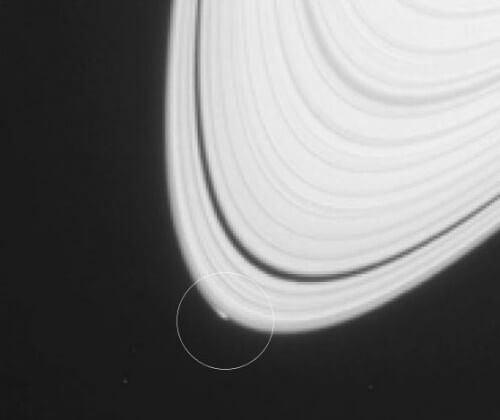"According to the theory, Saturn long ago had a much more massive ring system than the current one, which is capable of 'giving birth' to large moons," said the lead researcher on the team that discovered Peggy - Saturn's new tiny moon. "When moons formed near the edge of the ring, they were ejected from it"

The Cassini spacecraft recorded the formation of a small icy object inside Saturn's rings. The object, known informally as Peggy (Peggy) may, according to NASA, be a new moon. Details of the sightings were published this week in the online version of the journal Icarus.
"We have never seen anything like this" says Carl Murray (Murray) from Queen Mary University in London, the main researcher of the article. "We may have been watching the moon's birth in action, just as the object left the rings and made its way out to become an independent moon."
Images taken by Cassini's narrow-angle camera a year ago - on April 15, 2013 - show a disturbance at the edge of the A ring - the outermost of Saturn's bright rings. One of these disturbances, shaped like an arc about 1,200 km long and 10 km wide, was 20% brighter than its surroundings. The scientists also discovered bumps in the ring's normally smooth boundary line. The scientists estimate that this bulge was caused by the gravitational influence of a nearby bone.
The object is not expected to grow, it may even disintegrate, but the process of its creation and outward movement help to understand how the icy moons of Saturn, including Titan with the clouds and Enceladus which carries an ocean beneath the ice, may have formed in much larger rings in the past. This phenomenon also provides insight into the way Earth and other planets in the solar system might have formed close to the Sun and moved away from it.
"Watching the possible birth of a tiny moon is an exciting and unexpected event," says Cassini project chief scientist Linda Spilker of NASA's Jet Propulsion Laboratory in California. According to Spilker, Cassini's orbit will bring it close to the outer edge of the A ring in late 2016 and provide an opportunity to study Peggy in more detail and possibly even photograph it.
The Peggy Moon is too small to be seen in images so far. The scientists estimate that its diameter is about a kilometer. The diameter of Saturn's moons depends on their proximity to the planet - the further away they are, the larger they are. Many of Saturn's moons are composed primarily of ice, as well as particles of Saturn's rings. Based on these facts, and other metrics, the researchers hypothesized that the icy moons formed from the ring particles and then moved outward, away from the planet as they merged with other moons along the way.
"According to the theory, Saturn long ago had a much more massive ring system than the current one, which is capable of 'giving birth' to large moons," said Murray. "When moons formed near the edge of the ring, they were ejected from it"
It is also possible that the process of creating moons from Saturn's rings ended with Peggy, as Saturn's rings today are, by all accounts, too sparse to produce more moons. Because of this, Murray and his colleagues tried to make the most of the few observations they were able to obtain.
